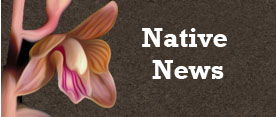NC Native Plant Society:
Plant Details
Maianthemum canadense [=Unifolium canadense]
Canada Mayflower, False Lily-of-the-valley, Canadian Lily-of-the-valley
Scientific Name: |
Maianthemum canadense [=Unifolium canadense] |
|---|---|
Genus: |
Maianthemum |
Species Epithet: |
canadense |
Common Name: |
Canada Mayflower, False Lily-of-the-valley, Canadian Lily-of-the-valley |
Plant Type |
Herb/Wildflower |
Life Cycle |
Perennial |
Plant Family |
Ruscaceae (Ruscus Family) |
Native/Alien: |
NC Native |
Invasive Status: |
(*Key) |
Size: |
0-1 ft. |
Bloom Color(s): |
White |
Light: |
Part Shade - 2 to 6 hours of sun per day, Less than 2 hours of sun per day |
Soil Moisture: |
Moist |
Bloom Time: |
May, June, July |
Growing Area: |
Mountains |
Habitat Description: |
Moist forests, especially at high elevations. Common across most of the NC mountains, at least at the higher elevations. |
Leaf Arrangement: |
Alternate |
Leaf Retention: |
Deciduous |
Leaf Type: |
Leaves veined, not needle-like or scale-like |
Leaf Form: |
Simple |
Life Cycle: |
Perennial |
Wildlife Value: |
Important for Wildlife |
Landscape Value: |
Not Recommended for home landscapes |
State Rank: |
S5: Secure (*Key) |
Global Rank: |
G5 - Secure (*Key) |
Notes: |
Difficult to grow outside its cool mountain habitat. |
|
Flowers of Canada Mayflower emerge as a short, compact raceme from 1-3 clasping shiny green leaves. White petals are small. Slightly longer white stamens protrude.
Will Stuart |
|
|
Masses of Canada Mayflower along the Flat Rock Trail near Grandfather Mountain, NC
Will Stuart |
|
|
Brightly colored fruits develop by mid-August.
|
|
|
Senescing flowers with developing fruit. Julian Price Memorial Park, Watauga Co., NC
Bettina Darveaux |
|
|
A very short plant, only 4-6 inches tall. Julian Price Memorial Park, Watauga Co., NC
Bettina Darveaux |
|
|
Typically grows in very dense stands in a relatively small area. Julian Price Memorial Park, Watauga Co., NC
Bettina Darveaux |
|
Links: |
|
back to top
go to plant details search
go to plant images search
go to gallery home
back to Initial m Gallery
back to orchids
back to Carnivorous Plants
back to Trilliums

![Flowers of Canada Mayflower emerge as a short, compact raceme from 1-3 clasping shiny green leaves. White petals are small. Slightly longer white stamens protrude. of Maianthemum canadense [=Unifolium canadense] The Scientific Name is Maianthemum canadense [=Unifolium canadense]. You will likely hear them called Canada Mayflower, False Lily-of-the-valley, Canadian Lily-of-the-valley. This picture shows the Flowers of Canada Mayflower emerge as a short, compact raceme from 1-3 clasping shiny green leaves. White petals are small. Slightly longer white stamens protrude. of Maianthemum canadense [=Unifolium canadense]](https://ncwildflower.org/images/plants/Maianthemum_canadense_20110513_0031.jpg)
![Masses of Canada Mayflower along the Flat Rock Trail near Grandfather Mountain, NC of Maianthemum canadense [=Unifolium canadense] The Scientific Name is Maianthemum canadense [=Unifolium canadense]. You will likely hear them called Canada Mayflower, False Lily-of-the-valley, Canadian Lily-of-the-valley. This picture shows the Masses of Canada Mayflower along the Flat Rock Trail near Grandfather Mountain, NC of Maianthemum canadense [=Unifolium canadense]](https://ncwildflower.org/images/plants/Maianthemum_canadense_20110523_0036.jpg)
![Brightly colored fruits develop by mid-August. of Maianthemum canadense [=Unifolium canadense] The Scientific Name is Maianthemum canadense [=Unifolium canadense]. You will likely hear them called Canada Mayflower, False Lily-of-the-valley, Canadian Lily-of-the-valley. This picture shows the Brightly colored fruits develop by mid-August. of Maianthemum canadense [=Unifolium canadense]](https://ncwildflower.org/images/plants/Maianthemum_canadense_20110810_0078.jpg)
![Senescing flowers with developing fruit. of Maianthemum canadense [=Unifolium canadense] The Scientific Name is Maianthemum canadense [=Unifolium canadense]. You will likely hear them called Canada Mayflower, False Lily-of-the-valley, Canadian Lily-of-the-valley. This picture shows the Senescing flowers with developing fruit. of Maianthemum canadense [=Unifolium canadense]](https://ncwildflower.org/images/plants/Maianthemum_canadense%C2%A0_IMG_5218_BD.jpeg)
![A very short plant, only 4-6 inches tall. of Maianthemum canadense [=Unifolium canadense] The Scientific Name is Maianthemum canadense [=Unifolium canadense]. You will likely hear them called Canada Mayflower, False Lily-of-the-valley, Canadian Lily-of-the-valley. This picture shows the A very short plant, only 4-6 inches tall. of Maianthemum canadense [=Unifolium canadense]](https://ncwildflower.org/images/plants/Maianthemum_canadense%C2%A0_IMG_5229_BD.jpeg)
![Typically grows in very dense stands in a relatively small area. of Maianthemum canadense [=Unifolium canadense] The Scientific Name is Maianthemum canadense [=Unifolium canadense]. You will likely hear them called Canada Mayflower, False Lily-of-the-valley, Canadian Lily-of-the-valley. This picture shows the Typically grows in very dense stands in a relatively small area. of Maianthemum canadense [=Unifolium canadense]](https://ncwildflower.org/images/plants/Maianthemum_canadense%C2%A0_IMG_5231_BD.jpeg)


